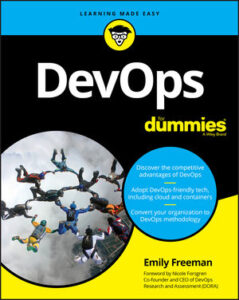I’m really bad and lazy about posting book reviews. This book was published in 2019. I discovered it last year and have found it super helpful. It is in no way out of date. So I’m going to go ahead and share my thoughts on it!
I’ve been part of teams who succeeded with continuous delivery for the past 15 years. And, I am still learning new things about continuous delivery! We are fortunate to have lots of great resources for learning about continuous integration, continuous delivery, DevOps, observability, and more of those activities in our holistic testing loop. See my “Observability, Continuous Delivery, DevOps and Related Resources” page for a list of books, articles, courses, videos and more contributed by many folks in our community.
 DevOps for Dummies by Emily Freeman has been so helpful to me over the past several months. I devote a lot of time to helping software practitioners, especially testing specialists, get engaged in the practices associated with DevOps. Abilities like asking good questions, spotting anomalies, analyzing risks, and debugging problems are helpful on both sides of the DevOps loop.
DevOps for Dummies by Emily Freeman has been so helpful to me over the past several months. I devote a lot of time to helping software practitioners, especially testing specialists, get engaged in the practices associated with DevOps. Abilities like asking good questions, spotting anomalies, analyzing risks, and debugging problems are helpful on both sides of the DevOps loop.
This book has helped me improve my own ability to help people learn about DevOps. Emily starts out by explaining the most important aspect of DevOps – the cultural transformation. She uses the CALMS model – culture, automation, lean, measurementand sharing – to help readers understand DevOps principles and how to apply them to their own organizations. The book emphasizes collaboration, teamwork, and values throughout.
Chapter 11, Deploying a Product, is my favorite. It’s a concise and easy to follow introduction to continuous integration, continuous delivery and continuous deployment. The explanations of release strategies such as blue-green deployment and rolling deployment have such helpful illustrations. Combining these with examples from my own experience have been a great way for me to help others grasp these concepts quickly. Emily includes lots of examples from various organizations, too.
Most chapters focus on the people side of DevOps – rightly so. Chapter 16, Embracing Failure Successfully, is another of my favorites. Establishing a psychologically safe environment where teams feel free to experiment and make mistakes is a well-known prerequisite to successful software delivery.
There’s plenty of great technical advice here, such as strategies for choosing the right infrastructure and tools. The advice for being successful as humans is even more important. Chapter 23, on the Top Ten DevOps Pitfalls, sums those up perfectly.
If you’re new to DevOps, this book will empower you to join the conversations about continuous integration, continuous delivery, infrastructure and more with your own teams. If you’re like me and you have a fair amount of experience working on teams successfully embracing a DevOps culture, you’ll want this book to hand whenever you need some clarification or help explaining a concept to someone else.
I’ve never been a fan of the “XXXXXX for Dummies” book title. You’re not a dummy if you’re new to DevOps. I think of this book as DevOps for Humans. Check it out!


